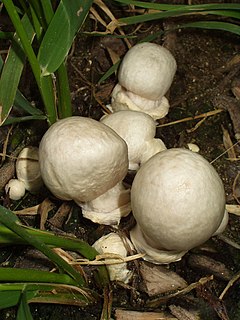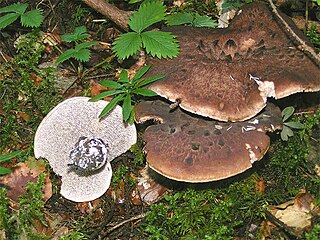
Mycology is the branch of biology concerned with the study of fungi, including their genetic and biochemical properties, their taxonomy and their use to humans as a source for tinder, traditional medicine, food, and entheogens, as well as their dangers, such as toxicity or infection.

The name destroying angel applies to several similar, closely related species of deadly all-white mushrooms in the genus Amanita. They are Amanita bisporigera and A. ocreata in eastern and western North America, and A. virosa in Europe. Another very similar species, A. verna or fool's mushroom, was first described in France.

Psilocybin mushrooms; commonly known as magic mushrooms, mushrooms or shrooms, are an polyphyletic informal group of fungi that contain psilocybin which turns into psilocin upon ingestion. Biological genera containing psilocybin mushrooms include Copelandia, Gymnopilus, Inocybe, Panaeolus, Pholiotina, Pluteus, and Psilocybe. Psilocybin mushrooms have been and continue to be used in indigenous New World cultures in religious, divinatory, or spiritual contexts. Psilocybin mushrooms are also used as recreational drugs. They may be depicted in Stone Age rock art in Africa and Europe, but are most famously represented in the Pre-Columbian sculptures and glyphs seen throughout North, Central and South America.

Pleurotus ostreatus, the oyster mushroom, oyster fungus, or hiratake, is a common edible mushroom. It was first cultivated in Germany as a subsistence measure during World War I and is now grown commercially around the world for food. It is related to the similarly cultivated king oyster mushroom. Oyster mushrooms can also be used industrially for mycoremediation purposes.

The Sciaridae are a family of flies, commonly known as dark-winged fungus gnats. Commonly found in moist environments, they are known to be a pest of mushroom farms and are commonly found in household plant pots. This is one of the least studied of the large Diptera families, probably due to the small size of these insects and the difficulty in specific identification.

The Clavariaceae are a family of fungi in the order Agaricales. Collectively, they are commonly known as coral fungi due to their resemblance to aquatic coral, although other vernacular names including antler fungi, finger fungi, worm mold, and spaghetti mushroom are sometimes used for similar reasons.

Boletus is a genus of mushroom-producing fungi, comprising over 100 species. The genus Boletus was originally broadly defined and described by Carl Linnaeus in 1753, essentially containing all fungi with hymenial pores instead of gills. Since then, other genera have been defined gradually, such as Tylopilus by Petter Adolf Karsten in 1881, and old names such as Leccinum have been resurrected or redefined. Some mushrooms listed in older books as members of the genus have now been placed in separate genera. These include such as Boletus scaber, now Leccinum scabrum, Tylopilus felleus, Chalciporus piperatus and Suillus luteus. Most boletes have been found to be ectomycorrhizal fungi, which mean that they form a mutualistic relationship with the roots system of certain kinds of plants. More recently, Boletus has been found to be massively polyphyletic, with only a small percentage of the over 300 species that have been assigned to Boletus actually belonging there and necessitating the description and resurrection of many more genera.

The Thelephorales are an order of fungi in the class Agaricomycetes. The order includes corticioid and hydnoid fungi, together with a few polypores and clavarioid species. Most fungi within the Thelephorales are ectomycorrhizal. None is of any great economic importance, though Sarcodon imbricatus is edible and commercially marketed, whilst several species have been used for craft dyeing.

Gymnopilus junonius is a species of mushroom in the family Cortinariaceae. Commonly known as the spectacular rustgill, this large orange mushroom is typically found growing on tree stumps, logs, or tree bases. Some subspecies of this mushroom contain the neurotoxic oligoisoprenoid gymnopilin.

Cephalanthera austiniae is a species of orchid known as the phantom orchid and snow orchid because the entire plant is white except for a few yellow markings on the flowers.

Hydnellum is a genus of tooth fungi in the family Bankeraceae. Widely distributed in the Northern Hemisphere, the genus contains around 40 species. The fruitbodies of its members grow by slowly enveloping nearby bits of grass and vegetation. There is great variability in the form of Hydnellum fruitbodies, which are greatly influenced by environmental conditions such as rainfall and humidity, drying winds, and temperature. They are too tough and woody to eat comfortably. Several species have become the focus of increasing conservation concern following widespread declines in abundance.

The Bolbitiaceae are a family of mushroom-forming basidiomycete fungi. A 2008 estimate placed 17 genera and 287 species in the family. Bolbitiaceae was circumscribed by mycologist Rolf Singer in 1948.

Phellodon is a genus of tooth fungi in the family Bankeraceae. Species have small- to medium-sized fruitbodies with white spines on the underside from which spores are released. All Phellodon have a short stalk or stipe, and so the genus falls into the group known as stipitate hydnoid fungi. The tough and leathery flesh usually has a pleasant, fragrant odor, and develops a cork-like texture when dry. Neighboring fruitbodies can fuse, sometimes producing large mats of joined caps. Phellodon species produce a white spore print, while the individual spores are roughly spherical to ellipsoid in shape, with spiny surfaces.

Hydnellum aurantiacum is an inedible fungus, commonly known as the orange spine or orange Hydnellum for its reddish orange or rusty red colored fruit bodies. Like other tooth fungi, it bears a layer of spines rather than gills on the underside of the cap. Due to substantial declines in sightings, this species is listed as critically endangered in the United Kingdom.

Polyozellus is a fungal genus in the family Thelephoraceae, a grouping of mushrooms known collectively as the leathery earthfans. A monotypic genus, it contains the single species Polyozellus multiplex, first described in 1899, and commonly known as the blue chanterelle, the clustered blue chanterelle, or, in Alaska, the black chanterelle. The distinctive fruit body of this species comprises blue- to purple-colored clusters of vase- or spoon-shaped caps with veiny wrinkles on the undersurface that run down the length of the stem.
The Aphyllophorales is an obsolete order of fungi in the Basidiomycota. The order is entirely artificial, bringing together a miscellany of species now grouped among the clavarioid fungi, corticioid fungi, cyphelloid fungi, hydnoid fungi, and poroid fungi.

Thelephora is a genus of fungi in the family Thelephoraceae. The genus has a widespread distribution and contains about 50 species. Fruit bodies of species are leathery, usually brownish at maturity, and range in shape from coral-like tufts to having distinct caps. Almost all species in the genus are thought to be inedible, but Thelephora ganbajun is a gourmet fungus in Yunnan province of southwest China.

Thelephora palmata is a species of clavarioid fungus in the family Thelephoraceae. The fruit bodies are leathery and coral-like, with branches that are narrow at the base before widening out like a fan and splitting into numerous flattened prongs. The wedge-like tips are whitish when young, but darken as the fungus matures. The common names of the fungus refers to its pungent odor, likened to fetid garlic. A widely distributed but uncommon species, it is found in Asia, Australia, Europe, North America, and South America, where it fruits on the ground in both coniferous and mixed forest.

Hot pot or hotpot, also known as soup-food or steamboat, is a cooking method that originated in China, prepared with a simmering pot of soup stock at the dining table, containing a variety of Chinese foodstuffs and ingredients.
Amaurodon caeruleocaseus is a species of fungus in the family Thelephoraceae. It was described by Sven Svantesson and Tom W. May in 2021. It is unique within its genus in that its basidiome is stipitate. The specific epithet is Latin, named for the basidiome's resemblance to blue cheese. The type locality is Denmark, Western Australia.


















